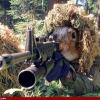-
Posts
472 -
Joined
-
Last visited
About killersquirrel59
- Birthday 09/17/1988
Profile Information
-
Member Title
Steel Inquisitor
-
Gender
Male
-
Location
Scadriel
killersquirrel59's Achievements
402
Reputation
-

What are the Men of Gold and Red?
killersquirrel59 replied to 2spooky4myshirt's topic in Cosmere Discussion
My pet theory was that it represents an alliance of Autonomy and Odium, Autonomy being red as reflected in the red flakes on Trellium (Bavadinium), the red eyes of the corrupted kandra, and the red glow of her Shard form when Sazed showed Wax the vision, and Odium being gold as reflected in his appearance as a gold-skinned singer, the golden appearance of Raysium, and his light being described as golden when he appeared in Shard form. But given what happened to Odium in Stormlight 4 that would have to assume that the colour-coding was somehow intrinsic to the shard rather than a preference of the holder and that seems very odd to me. -
Happy birthday!
Thanks for starting the best Nightwatcher related thread on the Shard!
-
Yes exactly. That is my point. The dissolved carbon atoms are being trapped in specific patterns, but by the very nature of those patterns, the distribution, while close enough to be considered even in even a small steel object, will not be chemically perfectly even in every minuscule flake.
-
I think there's a miscommunication. Assuming even late medieval blast furnace technology, the iron could be fully liquefied and thus have all of its impurities adequately removed, and I could even buy that they had access to something like the Bessemer process given their more advanced metallurgic technology. But the carbon is another matter. Carbon will not liquefy in anything remotely close to ordinary steel forges. Carbon has a melting point of 3550 degrees Centigrade, and even then it doesn't really melt, it sublimes (turning directly from solid to gas). As such, its distribution within the iron, no matter how well purified the iron has been through the Bessemer process or whatever means are being used, will not be perfectly even as would be the case when alloying two metals reduced to liquid state.
-
That is a good answer to be getting on with. I was preoccupied with the physical nature of the metal and didn't fully consider the cognitive aspect of whether or not the steel flake still saw itself as part fo the steel bar it was shaved from. It's not a fully satisfactory answer and feels a bit like a cop out, but it is enough that I can live with it if no other revelations present themselves.
-
So, completely unrelated to Cosmere work, I was doing some research into the nature of metallurgy, specifically carbon structures in steel, and came up with a problem that I haven't seen answered before. It has been well established that allomantic alloys must have precise percentages in order to be effective. For true metallic alloys such as bronze, pewter, and brass, this is not a problem, as the alloy process involves combining the elements involved by heating the components to liquid form. But steel is a problem. Carbon does not liquefy, and often neither does the iron (depending on furnace technology) during the steel forging process. As such, carbon is not evenly distributed through the steel. In larger products, this is mostly irrelevant, as the distribution of the carbon crystal structures in the iron is even enough function. However, this idea falls apart when considering something as small as the metal flakes consumed by allomancers. Because steel is not fully liquefied like other alloys, these flakes cannot possibly have even distribution of carbon in them, and thus will not match the perfect ratio necessary for allomantic efficacy, or even safety as it is strongly implied and in some places stated outright that a bad alloy can kill an allomancer when they burn it. Has this issue been addressed before and I just missed it? What are your thoughts on it? It seems a pretty large hole in one of the key rules of allomancy to have gone completely unnoticed, and I was quite surprised to not find anything on the topic.
-

Are All Terris Men Castrated (no baby making)?
killersquirrel59 replied to Arith Matic's topic in Mistborn
There is a major problem with the idea on the surface that the breeding program was meant to breed Feruchemy out of the Terris population. I fully accept that this is what was presented to the Obligators running the program (those who knew about Feruchemy in the first place at least), but there is a very important reason why the Lord Ruler needed to maintain at least a small number of Feruchemists. Inquisitors Each new Inquisitor the Lord Ruler wished to make required not only the sacrifice of 8 mistings and 1 mistborn or (less likely) Seer, but also 1 Feruchemist for the use of Feruchemical gold. Inquisitors are not immortal, and thus must periodically be replaced, and those pewter spikes needed to come from somewhere. As such, it follows that buried somewhere in the breeding program, there must have been some desire to create a small number of Feruchemists specifically to be sacrificed to make Inquisitors. A particularly morbid part of me actually wonders if infiltrations like Tindwyl's of the breeding program were known about all along and secretly allowed to happen, her offspring tracked and watched for any manifestation of Feruchemy so they could be taken for sacrifice. -
It's been a while since I've been on, but I had a thought while rereading Hero of Ages that is worth some consideration. Allomantic Savants are created by constantly flaring an allomantic metal long enough that it causes physical changes to the body. This prompted a 2 part question. 1) Can someone who gained their allomantic ability via a hemalurgic spike become an Allomantic Savant? 2) If so, what would happen if the spike was subsequently removed? I have my own ideas, but I'm curious what the Shard's hivemind thinks before I taint the pool with my original thoughts. So please, discuss.
- 13 replies
-
1
-

[OB] Why doesn't Shallan have Plate?
killersquirrel59 replied to TheDoomsday's topic in Stormlight Archive
Shallan is a weird case because of her self-denial. In addition to this, given the nature of the Lightweavers, it is often difficult to determine what counts as a Truth for the purpose of advancement. She already had her blade (3rd Ideal) when she was a young child, and we've seen her offer at least one more after that when she admitted she killed her father. She already had her blade at this point as she had thought about using it and recoiled from that thought. Clearly there are other conditions that need to be met for the Lightweavers, possibly accepting the truths more intrinsically than just giving them voice. It's also possible with her repressed memories that she is "rediscovering" her ideals already sworn instead of finding new ones and advancing. We simply don't have enough data on what is necessary for a Lightweaver's advancement to determine anything from Shallan's situation. -

[OB] What could the Fourth Windrunner Ideal be?
killersquirrel59 replied to TheDoomsday's topic in Stormlight Archive
Well, look at the gemstone library archive about the fourth ideal. This was a sapphire which is traditionally associated with Windrunners and the quote is "My spren claims that this recording will be good for me, so here I go. Everyone says I will swear the Fourth Ideal soon, and in so doing, earn my armor. I simply don’t think that I can. Am I not supposed to want to help people?" I think the key is "not supposed to want to help people". Given this hint and the moral progression of Kaladin with his massive guilt complex, I can only conclude that the Fourth Ideal for the Windrunners is something along the lines of "I will accept that I cannot save everyone". -
This change really bothered me, not because of how it affected the character, but really because of what it would mean for Kershtian culture. This was a very male-dominated culture, which served very well as a backdrop to Khriss, letting her be more pronounced as a stranger in that culture. Changing Kershtian culture to be more inclusive in this case only serves to weaken Khriss and her story.
-

Nightwatcher Boon/Bane (Game)
killersquirrel59 replied to killersquirrel59's topic in Forum Games & Random Stuff
(You have got to be kidding me. This thing is still going? I started this over 2 years ago). Granted, however, any amount of movement involves some degree of physical change on a tiny scale, so you are completely immobile, including your ability to breathe or your heart to beat, or electrical signals to fire in the brain, so you die rather quickly. I wish for the ability to stop time at will for as long as I want, whenever I want. -
Very interesting. That seems an odd choice for a gender swap. Not sure how that will work without some pretty big changes to Kershtian culture. He made a big deal of women being deferential in their culture, definitely being lesser citizens.
-
Has anyone considered that the corpseboat might have just been Hoid being deliberately weird? He does things like that, often for no readily apparent reason. Why would he attempt to storm with Kelsier as an informant in book 1? Why does he seem to have so much fun as Wit? He is clearly just the kind of guy who enjoys messing with people's minds and expectations. He even says it Way of Kings directly to Kaladin, smiling when he says he enjoys playing with the minds of Bridgemen. I took Spanky as just that, Hoid being weird for no particular reason. He might have needed some kind of boat or vessel, but I doubt it needed to be a corpse.



